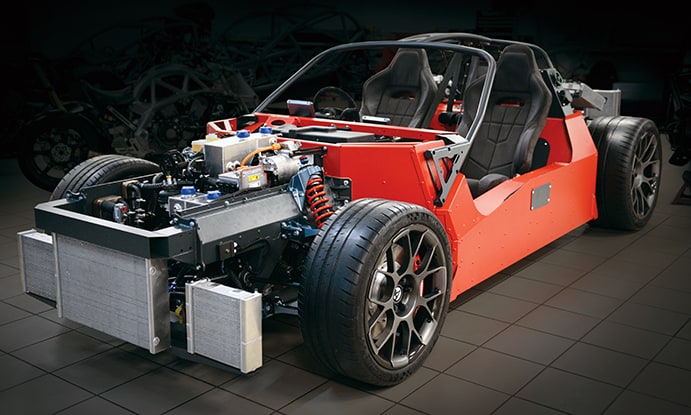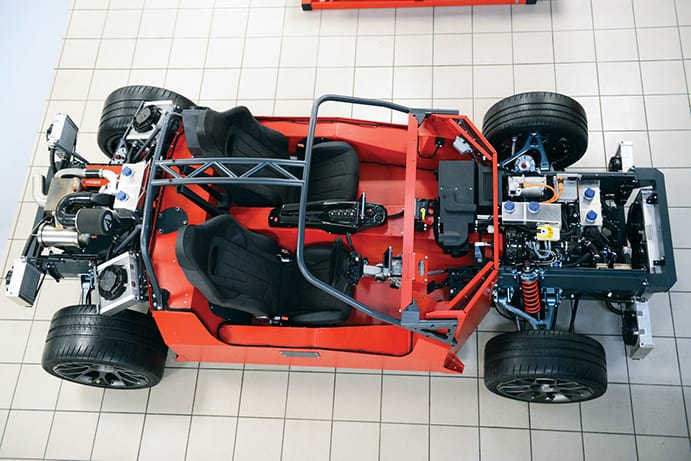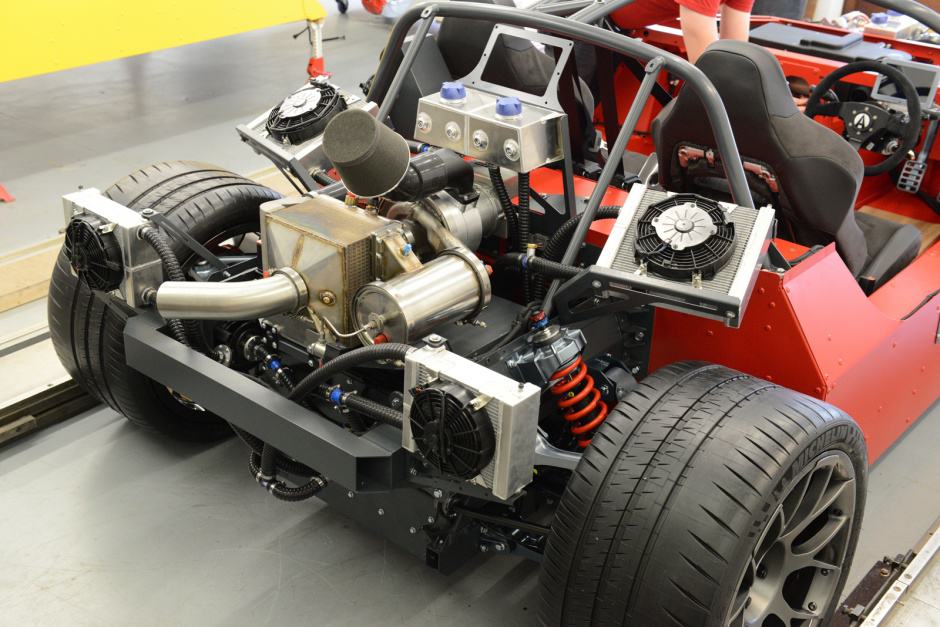With its gas-turbine-electric HIPERCAR, Somerset's Ariel Motor Company plans to rewrite the supercar rulebook.
Developing a new car platform from scratch is a huge undertaking. When this also happens to be a radical gas turbine-electric supercar, it would be deemed an extremely ambitious project for a global OEM, let alone a small, independent carmaker from Somerset.
Throw in the small matter of 1,180bhp, four-wheel drive and a physics-defying 0-100mph claim of 3.8 seconds and you’d be forgiven for thinking the concept had been plucked from the realms of fantasy. But the Ariel HIPERCAR is a project that deserves to be taken very seriously indeed.

For a start, Ariel has been realistic about how much it intends to take on. While the fundamentals of the design and development are indeed being handled in-house, the project is supported by an all-star cast of technical partners. Names on the roster include specialist firms such as Delta Motorsport, Equipmake and GKN Hybrid Drive, plus industry heavyweights Alexander Dennis, JCB and Johnson Matthey.
Strictly speaking the HIPERCAR tag does not refer to the vehicle itself – known internally as the P40 – but to the R&D project that spawned it. Short for High Performance Carbon Reduction, it was an Innovate UK-backed project based around a feasibility study carried out by Ariel in 2014. This investigated various hybrid architectures for a low-emissions sports car and concluded that a range-extended EV (electric vehicle) was the best option.
“You’re going to severely impact the range if you start using a meaningful percentage of the capability of a high-performance battery-only EV, so a range extender was always part of the plan,” explained Neil Yates, Ariel’s HIPERCAR project manager.
Maintaining the state of charge
Having carried out a lot of vehicle and systems-level simulation, the team concluded that the range extender would require “quite a significant output” to maintain state of charge during aggressive road driving. That was when they thought of using a gas turbine.
“If you look at the range extender offerings on the market already, they’re typically combustion engine based; they’re heavy, relatively inefficient and require significant packaging space. None of that feels very clever when you compare it with the rest of the platform,” said Yates.
The project has received more than £2m of grant funding, with electric motor designer Equipmake and gas turbine provider Delta Motorsport joining Ariel for the development phase, followed by the other partners. Each firm gets to retain the intellectual property it puts in to the project; and, while all the major technology has been developed specifically for the HIPERCAR, it has also been designed with scalability in mind.
“Very few manufacturers would have a specification requirement like ours, but the technology is absolutely applicable to other uses,” Yates pointed out. “You could see a scaled-down derivative of one of the motors finding its way into a mass-produced passenger car, or perhaps an enlarged version of the battery going onto a bus or an earth mover.”
Ariel unveiled the first two prototypes at the Cenex Low Carbon Vehicle Show at Millbrook in September. Crucially, when the covers came off, the crowds were greeted by a fully functioning rolling chassis, not a series of concept sketches or a styling mock-up (as is often the case with ambitious supercar start-ups).
At the same time, it was announced that the project had won a further £6m grant through the Advanced Propulsion Centre (APC), adding credence to Ariel’s claim that the car would be production ready by 2020.

As the second phase of development gets under way, the company is busy testing its two early-stage prototypes, with a further five development and validation vehicles due over the next 16 months.
The plan is to supply the P40 in two derivatives: a four-wheel-drive model with 1,180bhp (880kW) and a 590bhp model driving the rear wheels alone. Both will use one inboard-mounted 220kW motor unit on each driven wheel, complete with its own integrated epicyclic gearbox and inverter.
Developed by Equipmake in collaboration with Aim Co Japan, the design of these units is innovative, with the magnets arranged radially around the outside of the rotor like the spokes of a wheel. This is said to improve the torque density by as much as 25 per cent, while a sophisticated water-glycol cooling system enables the motors to run at high outputs for a prolonged period.
In each case, the floor-mounted lithium-ion battery pack forms a semi-stressed member of the chassis. However, the cell chemistry is different for the two variants. Delta Motorsport was responsible for the development of both designs but the two-wheel-drive battery pack fell under a separate £12m Innovate UK battery research project, headed by Warwick Manufacturing Group. It uses fewer cells than the four-wheel-drive variant and produces a lower total output, but at a higher energy density.
Challenges of thermal management
To overcome the challenges of thermal management in the packs, where average (RMS) power could be well in excess of 300kW, Delta has developed a unique liquid-cooling system. Refrigerated water-glycol coolant is fed directly to every cell in the pack, with a network of temperature sensors to actively control its distribution. The same modular system is used in both variants, and in four-wheel-drive form it enables the pack to operate at an impressive 1,500kW with peaks of up to 1,200A and 750V.
Ariel says an innovative charging system is also in development, which will enable the high-voltage battery pack to be charged from a conventional (i.e. sub-500V) CHAdeMO or Type 2 socket. The aim is that a full charge will give the car an electric-only range of around 120 miles for normal road driving.
Beyond that, the 35kW range extender should be enough to maintain charge during normal road use (giving a combined range of about 500 miles on a full tank/charge). For track use, however, it’s anticipated that either the range extender or the plug-in capability will need to be used to charge the car in between runs. This should give about 15 minutes of flat out running at a high speed circuit like Spa or Silverstone, before the range extender is required to get the car back to the pits.

The micro-turbine system is another Delta Motorsport Innovation. It runs on regular pump petrol, spinning at a constant 120,000rpm once it’s up to speed. The combustion system incorporates a recuperator, which is one of a number of features that are said to address the emissions challenges traditionally encountered with gas turbines. Overall, Ariel says the tailpipe emissions should be less than those of a typical city car (quite an achievement, considering it’s expected to comfortably outpace a Bugatti Veyron from 0 to 150mph).
There were a number of concerns when the engineers first started looking at using an onboard turbine, Yates admits. One of those was the NVH implications of something spinning at 120,000rpm directly behind the occupants’ heads.
“What you don’t realise when driving a combustion-engined vehicle is how many other noises there are in the car,” he says. “You get that in any EV, but here it exacerbates the challenge of managing the noise of the turbine. It’s been a really interesting challenge; we’ve actually managed to make a feature of the range extender noise.”
Another question mark hung over the thermal management, but the exhaust tailpipe temperatures turned out to be very similar to that of a conventional internal combustion engine. Despite its high internal temperatures the turbine doesn’t require any direct cooling; the electrical half of the range extender, meanwhile, is part of the same multi-circuit water-glycol heating and cooling system as the charging inverter and the DC/DC converter.
Durability testing
There’s still plenty of work to be done. The main task now is carrying out durability testing in order to ensure that the car is not just capable of doing 0-to-150mph in 7.8 seconds once, but time after time. Although it will be a relatively low volume model – with projected sales of less than 100 cars a year – Ariel is keen to stress that it is intended as a viable commercial proposition, not simply a concept car or a one-off.
Prices have yet to be confirmed (“more than an [Ariel] Atom and less than a Veyron”, quips Yates) but the production-ready model is due to be unveiled in 2019, with deliveries beginning in 2020. By that point it will have a new name to replace the current in-house designation, plus a fully enclosed carbon-fibre body. Under the skin, however, the company promises it will remain every bit as crazy as the prototypes you see here.
If they can pull it off, it will be a massive coup for this small independent manufacturer – one made possible, at least in part, by the unique way the project has been structured. And given the company’s track record, not to mention to the heavyweight engineering talent supporting it, the omens look very good indeed.




Project to investigate hybrid approach to titanium manufacturing
What is this a hybrid of? Superplastic forming tends to be performed slowly as otherwise the behaviour is the hot creep that typifies hot...